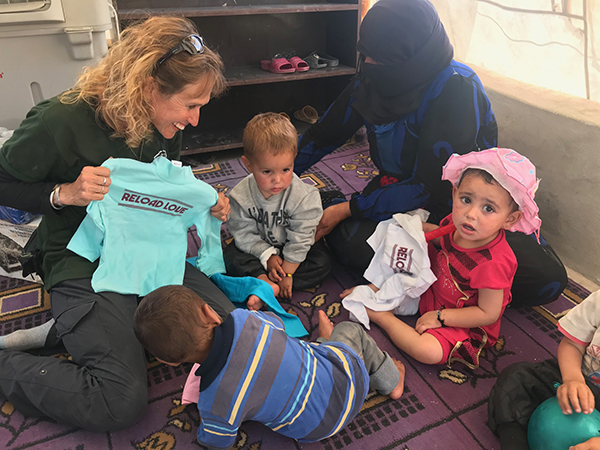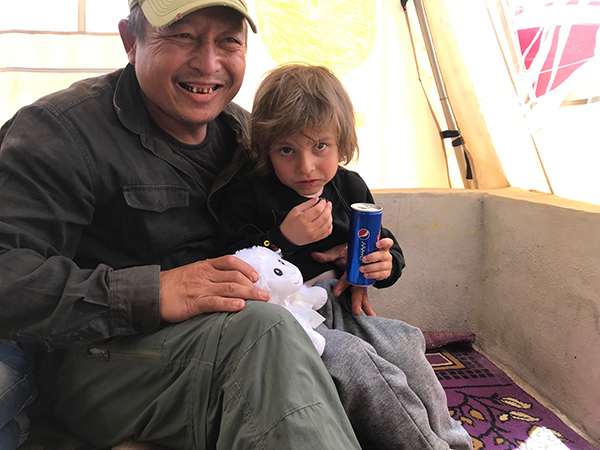Dear friends,
This is a report on the fall of the last physical stronghold of ISIS and what has happened to the women and children of ISIS. We are sending this report out again as there has not been improvement and the situation is more desperate and dangerous there.
Thank you and God bless you,
Dave Eubank
Children of ISIS: Stand Against Evil, Show Them Another Way
28 June 2019
Syria

This is a follow-up report to our missions into Baghouz and Al-Hawl, Syria. For more reports from those missions, please visit our website and see the accompanying video on YouTube.
The Rise and Fall of ISIS
In March 2019, the Islamic State lost the brutal battle of Baghouz and its last territorial holdings. At the height of its power the militant group had held territory stretching from Raqqa, Syria, up to the Turkish border and nearly all the way to Baghdad, with smaller pockets scattered throughout Syria – some 40,000 square miles, or an area roughly the size of Switzerland. With roots in Anbar Province of Iraq, they had taken advantage of the unrest in Syria to build their strength and had launched from there in 2014, quickly sweeping across eastern Syrian into Iraq and scoring perhaps their biggest victory by taking the largest city in northern Iraq, Mosul, in June of 2014. From there they made officially known the scope of their ambition: they were not just conquering land and people, they were establishing a caliphate. That is, Abu Bakr al Baghdadi was the self-appointed ruler of Muslims everywhere. He was the pope and the president rolled into one and their war was a holy one.
This message, delivered in the flush of victory – and the taking of Mosul was a huge victory, delivering into their hands all the money in the banks there, weapons and military apparatus from the local Iraqi Army bases, a nearly clear path south toward Baghdad and lucrative oil fields – this message brought tens of thousands of Muslims to join the caliphate from all over the world. Baghdadi had told them it was their duty and they came. They came, not to fight just for land or money or a leader – but to fight for God. They came committed. It’s estimated that some 40,000 fighters from 80 different countries flocked to Iraq and Syria to fight with ISIS.
In 2015, the slow pushback began. ISIS lost Kobani in Syria and Sinjar in Iraq. After taking Ramadi, Iraq, early in the year, they lost it again by the end. Momentum was building against them and 2016 saw continued losses: they lost the strategically and symbolically key city of Fallujah. They lost Membij in Syria and the religiously significant city of Dabiq. And, in October of 2016, the fight to retake Mosul began.
Their territorial decline continued steadily in 2017: after nine months of hard fighting, ISIS lost the city of Mosul, their capital in Iraq. Just months later in December 2017, they lost Raqqa, the so-called capital of the caliphate; according to US Secretary of State Rex Tillerson, they “had one foot in the grave.” However, their ability to inflict damage seemed unaffected. According to the National Consortium for the Study of Terrorism and Responses to Terrorism (START), in 2017, ISIS was directly or indirectly connected to more than 1300 attacks across the globe, and the deaths of more than 7000 people, including perpetrators. These included high profile terrorist attacks in western cities, as well as attacks in North Africa, Asia, and of course, the Middle East. Muslims, as well as non-Muslims, were their targets.
It would take more than one year for the Syrian Democratic Forces (SDF) and international coalition forces to get that last foot ‘in the grave’ with the defeat of Baghouz. Still, despite the loss of all territorial holdings, few believe that ISIS is totally defeated.

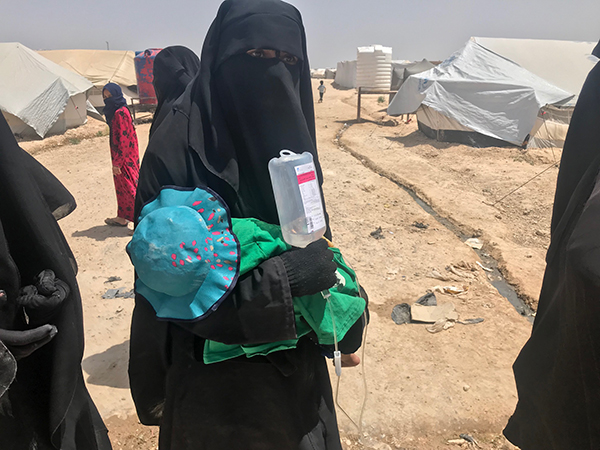
Al-Hawl Camp
Al-Hawl refugee camp in northeastern Syria, where the last remnants of ISIS were shipped to as they fled Baghouz, is a sprawling, dusty tent city, just 40 straight-line miles from Sinjar City, where ISIS committed some of its greatest atrocities in 2014 against the Yezidi people. Today, in a dramatic reversal, some 73,000 people, mostly ISIS families, live in captivity in Al-Hawl. They are primarily women and children (91%), with 65%, or over 47,000, being children under the age of 12. More than 3,000 children are separated from or without any adult family members. Most of these have arrived just since December, when the camp had just a little over 10,000 people.
At that time, ISIS was reduced to a final few villages along the Euphrates River near the Iraq border. The battle for the final village, Baghouz, kicked off on Feb. 1. Here were the last remnants, the most determined fighters, the hardened core of ISIS, who had survived multiple defeats and not lost heart, not changed loyalties, not doubted their cause. At that time, U.S. military estimates put their numbers at about 3,000 people. Negotiations at the start of the battle gave ISIS families, or “civilians”, an opportunity to evacuate the village before the fighting really began. As the evacuation began, it became clear that the tendency to underestimate ISIS that had characterized much of their rise was still in play.
Some 35,000 people eventually poured out of an area roughly one square mile in size. One woman told us that each person had a three-by-six-foot space to live in. Some walked out and were met by our FBR team who gave immediate first aid and food until they could be screened by the SDF and US forces and sent on to detainment camps. Others were loaded into big lorries, bumping over desert roads with only the things they could carry. Many had been wounded during the fighting they had been fleeing for the last year. They were all dropped off at the desert screening points, where our team met them and provided relief while they were screened and then loaded back up again to be sent to the next place; for the majority, this was Al-Hawl camp.
We had been the only aid group there providing help. We had given food and other supplies to some 25,000 people and treated 4,000 wounded. We had talked with some of these mostly women and children, been thanked by a few and cursed by others. There in the desert, the wind whipping dust into their eyes, no food, no water, no shelter, human feces everywhere, and surrounded by the SDF, their captors with guns, few of these women had been repentant. They were desperate and took the aid we gave them, but few were repentant.
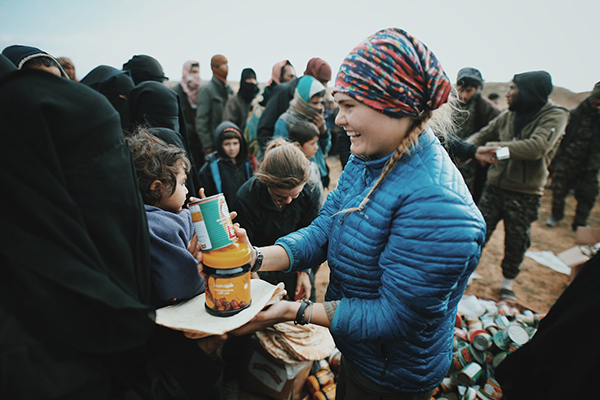
Now, in Al-Hawl camp, the ISIS women have become leaders. They have instituted Sharia law and women and girls in the camp are completely covered. Some foreigners want to go home, but not all. We talked to one German woman who said she’d rather stay there than go home to Germany.
“What would I do there?” she asked. “I want to start a new life here, with my husband. Not alone.”
This, standing outside a dusty white tent stamped with the blue “UN” logo, one among 10,000 others exactly the same, each one holding on average seven people. Like the German woman, most of the women want to know where their men are: they all have husbands, brothers or sons who were captured or killed in the fighting and they don’t know their fate. This makes them sad and angry.
One woman, named Taslem, abruptly pulled off her face covering while talking to us and said she wanted to join the SDF. We learned that she was from Deir ez-Zor and had been forced into a marriage as the third wife of a local man. He later divorced her and had been captured by the SDF. She claimed that his teen-aged children from his other wives were building car bombs at an ISIS facility in Abu Kamal. She also affirmed that many of the women in the camp, particularly widows of the last battles of Hajin and Baghouz, were still strong ISIS believers and enforced a strict dress code, threatening violence to violators. These women, she said, are in contact with outside ISIS elements.
According to other interviews, the refugees at Al-Hawl are also subject to many of the abuses suffered by vulnerable refugees everywhere: abuse by guards, threats of being trafficked, physical and sexual abuse, theft or ‘confiscation’ of personal belongings and unequal access to facilities. One woman we talked to claimed that Syrians and Iraqis in the camp received preferential treatment.

While in Al-Hawl camp we were able to do three Good Life Club programs. The SDF led us to three “education zones” where some of the children who had been orphaned were separated from the mass of other children in the camp. Many of them had also sustained serious injuries. Inside a chain link fence they were able to go to school inside tent classrooms and received care and attention from dedicated staff. We sang songs with them, taught them some basic health care, gave them shirts and snacks – sharing Jesus’ love with them. Through a skit, we taught them that God wants to free you from your burdens and help you. We thanked the staff for their work – most of them were from the area and had lived under ISIS until they were defeated by the SDF three years before.
The children responded with some bewilderment and then joy at this group of foreigners coming to hang out with them, sing with them, play with them, and not demand anything of them. As we got into goofy songs and skits, they turned into kids again. They laughed with us, sang with us, wolfed down snacks, posed for pictures and had a good time. One boy, about 13, who’d lost both his legs in an airstrike, laughed and did wheelchair wheelies in the tent where we had our program. He had a friend about his age helping him; when I looked more closely at his friend, I saw that while he had legs, one of his hands had been mangled by shrapnel.
In the meantime, outside the chain link fence, the hundreds of children not inside were wild with curiosity about what we were doing and desperate to get anything we were giving away. They surrounded the fence, climbing part way up it, hanging on it, rattling it, until guards came and chased them away. They climbed on our vehicles, cutting some of the cords that were tying down our loads. They scrawled ISIS slogans in the dirt on the sides of the vehicles. We were able to talk to some of them.
One 13-year-old boy had lost his arm in an airstrike. He was a local, living at his home in Hajin (one of the towns taken in the months preceding the Baghouz battle) when an airstrike hit his home. He knew the Americans were responsible but didn’t know why they would have been attacking them. Another boy, 12 years old, had been shot in the leg by a sniper. He said his tent had caught fire and when he ran out to escape, he was shot right away. Both of these boys had fathers in jail and mothers with them there in the camp.
Mohammed, a 14-year-old boy from Trinidad, and Abdullah, a 12-year-old boy from Pakistan, are two orphans who don’t live in the oasis inside the chain-link fence. They are not local and were both brought to Syria by a parent.
Mohammad recalls being scared to move to Syria five years ago. He was brought by his father, along with his two older sisters and an older brother and at least one of his father’s wives.
“I asked my dad why can’t we go back to home. He said, because this is how Islam is.”
Mohammed’s dad doesn’t seem to have convinced his family. One of his wives and his two daughters returned to Trinidad after arriving to Syria. Mohammed’s older brother, at 16, was helping people escape ISIS when he was caught and executed. Mohammed himself was jailed by them for stealing a motorcycle.
Mohammed had been living in Raqqa with his remaining family when that city was taken and they had moved to another place temporarily before arriving in Baghouz. He told of visiting a friend and returning home to find his home destroyed by a coalition air strike; his father and two siblings – one six years old and one four months old – were all killed.
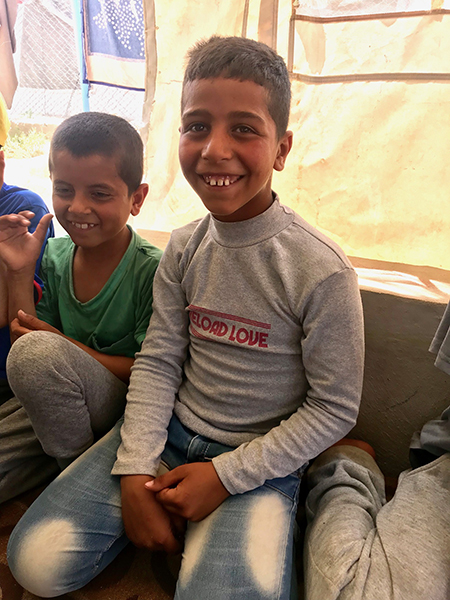
Abdullah is from Pakistan and said he was “too young” when his mom brought him to Syria, along with two brothers and two sisters.
“I asked, ‘Why did you bring me?’ She said now you are Islam.”
The day he lost his family he says, “I was outside, suddenly I listen: the bomb was coming. When I went home I saw my mom was dead.” He found a Facebook number in her bag and has been in contact with his family in Pakistan but today he is still in the camp.
Mohammed had no opportunity to go to school under ISIS and Abdullah went for a while but did not like it. English is their third language but they have difficulty reading and writing. In the camp they spend their days in a tent avoiding the heat, there is no school for them to attend. Mohammad remembers FBR’s bread distribution while fleeing Baghouz. Their dreams are to return back to their home countries and be with their families again.
Currently, the SDF – Kurd, Arab, Christian, Yezidi political confederation of uneasy allies, barely four years old – has been left to handle, almost by itself, the most acute global security threat of the new millennium, while at the same time being pressured by Turkey in the north and Assad, who is backed by Russia and Iran, in the west. Children like Mohammed, who don’t love ISIS and just want to go home, are simmering all day long in a hot tent wondering why they can’t leave, why their families were killed, and why no one is helping them. All the while, the question of what to do with these ISIS families is batted around the international community with little coherent action being taken. We believe ISIS families need to go home (see report here) and be given justice and love as appropriate, by their home countries and governments.
A Reunion in the Camp
On our last visit to Al-Hawl, we had a reunion. The day before, while waiting for a meeting in the central office area, which was also where camp inmates would come to receive outside visits or bring requests to the camp commanders, Suuzanne was recognized by one of the women there, who called out her name as she hurried over to hug her. The woman’s face was fully covered so we didn’t recognize her but soon realized that she was the mother of a girl we’d treated outside Baghouz, one of the ones who had escaped in the first days of the battle before the large scale evacuation began. Her daughter had been injured in an airstrike, suffering serious burns from her lower back all the way down her legs – serious enough that, in addition to the flesh wounds, she was paralyzed from the waist down.
When we met her in the desert, the girl, named Raghad, had an uncovered face and was smiling and cheerful. Her mother was active, attentive, and grateful, coming alongside our medic and helping in any way she could. We had spent just a few hours with them before the buses came to carry them to Al-Hawl. We helped carry Raghad onto the bus, she gave Suu a kiss on the cheek as they said good-bye, and they were gone. Now here was her mother. We told her we’d be back the next day and she should bring Raghad to this command post, as we weren’t allowed to visit them in their tent in the camp.

The next day Raghad was there. This time her face was covered in accord with the rules being imposed in the camp, but her eyes shone. We were only allowed to see her for a few minutes before the guards said she had to leave. We prayed for her and promised to send more help and do what we could to get her out. Then she was carried back through the fence and to her tent, and we left the camp soon after.
Her mom had somehow procured small gifts for each one of us and handed them out in pink gift bags covered in hearts. When we opened them later, it was all jewelry, necklaces, bracelets, a silver ring for Dave. The pendant on each piece was a silver, jeweled, zigzag line that looked like an EKG line, with a heart at the end. In a way, it seemed an apt metaphor – but one that could cut two ways.
University of ISIS
While ISIS has been seriously degraded with the loss of all its territory, its leaders on the run and in hiding, and rumors of insurrection and disunity in the leadership, the ISIS idea is alive and well. At the very least, thousands of women and children in Al-Hawl camp are clinging to the idea and see themselves as the seeds of the resurgence.
One of our Kurdish friends, a general back in Kurdistan, called Al-Hawl “ISIS University.”
“If we do not do something for the children, it will be worse. They are getting an education of hate and they will see no hope and no other way,” he said.
Over 20,000 ISIS members have gone underground in Syria and Iraq. In May alone, at least 78 deaths occurred in northeastern Syria as a result of 139 ISIS sleeper cell attacks. Deaths are up 42 percent since April and attacks up 61 percent. In April there was one ISIS attack a week in the areas we were working. By the time we left Syria on this last mission it was two attacks a day. In the camps, ISIS threatens anyone who breaks the rules, such as by wearing the head and face coverings. This week ISIS called all who tried to leave the camp ‘traitors’ and threatened to burn the remaining Australian children in the camp. This was after the Australian government took eight orphans out of the camp. That is the bad news: ISIS still has a heartbeat, it’s alive.

Hope Remains
But there is good news, too, and there is hope. We met many women and children who said they were sorry and renounced ISIS and its way. Families like Raghad’s and others who yearn for another way. Children like the orphans who had no choice of where they were born and are desperate for love and a new life. People like Lisa from Sweden and her two children who want to go home and who have parents who want them back.
“I am sorry, I was wrong, I want to go home,” she said.
Each individual person in the camp still has a heart also, pumping life through them. And so there is hope because living hearts can change. We believe that love is the most powerful change agent in the world. Love means standing against evil and at the same time extending a hand of mercy. Love is the difference between revenge and justice. Nations, like families, have the responsibility to care for their own. To leave the ISIS women and children in Syria is not only an unfair burden to the SDF, it does not result in justice but in hopelessness and only feeds the hateful ideology of ISIS. There is also historical precedent for mercy. The Nazis and Japanese Army killed far more people than ISIS and just as brutally, but we did not imprison, disown, and reject the wives and children of these soldiers. With one hand we must stop ISIS and with the other offer mercy, justice, and a chance to change.
We have tried to follow Jesus in sharing His love with the people we met in Baghouz and in Al-Hawl. Please pray with us for these people, and for a new way in Syria.
